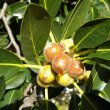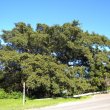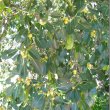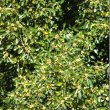Ficus burkei
| Botanical Name | Ficus burkei |
|||||||||||||||||||||
| Family | Moraceae - The fig and mulberry family. |
|||||||||||||||||||||
| Pronunciation | FY-kus BURK-ee-eye |
|||||||||||||||||||||
| Common Name(s) |
English: Common Wild Fig; Strangler Fig; Burkes Wild Fig
Afrikaans: Gewone Wildevy; Wurgvy
IsiZulu: Umbombe; Umthombe
IsiXhosa: Uluzi; Umthombe
Setswana: Mmadintana; Moomo; Moumo; Muomo ; and
Sesotho sa Leboa: Moumo
Tshivenda: Muumo
IsiNdebele: Intenjane; Umtende
|
|||||||||||||||||||||
| Plant Group |
|
|||||||||||||||||||||
| Plant Size |
|
|||||||||||||||||||||
| Position |
|
|||||||||||||||||||||
| General Information |
|
|||||||||||||||||||||
| Specific Information | Ficus burkei is a medium to large sized tree of 15 - 18 meters with a well-shaped spreading crown that can be twice as wide as it is tall. The mid- to dark green leaves are leathery, fairly stiff, usually hairless, elliptic in shape and vary in length from 3 to 12 cm long. The bark is pale to dark grey and smooth but gets rougher as the tree ages. Both the bark and leaves contain a white sticky latex. The tree is evergreen in wetter habitats but may be briefly deciduous in drier climates. The tree often starts as a strangler, germinating in the fork of another tree and sending aerial roots to the ground, eventually strangling the host tree. The tree is also known to be a 'rock splitter', germinating in the crack of a boulder which it splits apart as the tree grows. Ficus burkei has adapted well outside its natural distribution range, into the eastern and northern parts of South Africa where it is often planted as a shade tree on farms. The tree provides deep shade and attracts a wide variety of birds 'en mass' when in full fruiting. The fruit is also eaten by humans, bats, and a number of smaller mammals. Ficus burkei is closely related to Ficus thoningii, which is very similar to, but not the same as, Ficus burkei. It was made synonymous with Ficus thoningii in 1990 but was re-instated as a valid species in 2003, leading to a great deal of confusion. For fascinating information about wasp pollinators and various species of the fig family, visit: http:/www.figweb.org/Figs_and_fig_wasps/index.htm
|
|||||||||||||||||||||
| Ad Break | ||||||||||||||||||||||
| Flowers | ||||||||||||||||||||||
| Description | As with all figs, the flowers are found within the fruit. Figs grow singly or in pairs and very occasionally on bare twigs. They are almost round in shape, 10-20 mm in diameter, densely hairy to almost hairless, yellowish or infrequently pink when ripe. |
|||||||||||||||||||||
| Season |
|
|||||||||||||||||||||
| Colour | ||||||||||||||||||||||
| Growth Rate |
|
|||||||||||||||||||||
| Plant Uses |
|
|||||||||||||||||||||
| Distribution and Habitat | in South Africa from the Eastern Cape, north to KwaZulu-Natal, Mpumalanga, Limpopo, Gauteng and North West Province, as well as in Swaziland, Mozambique, Zimbabwe, Botswana, Zambia, Malawi, Kenya, Tanzania, south eastern DRC and Uganda, in wet or dry forest, Savanna woodland and on rocky hillsides, up to an altitude of 1800 meters |
|||||||||||||||||||||
| Planting Suggestions | Ficus burkei is tolerant of most soil types, so plant into any suitable site, but keep moist while young. Grows well in full sun as well as shade. To grow from seed, dry the opened fig and then scatter seed, or lightly cover dry fig. Do not plant close to buildings, sewer pipes or swimming pools as the roots are highly invasive – as are the roots of most fig species. The fruits ooze latex when broken off, so it is not suitable for car parks and avoid planting over fish ponds as the latex clogs the gills of the fish. The old method of digging a deep hole and filling it with soil and compost has resulted in many trees failing to thrive, dying, rotting at the base or worse still, falling over in later years due to poor root development. Refer to the following sites for the best method of planting trees: International Society of Arboriculture: New Tree Planting Tree People: Plant the right way For those of you who have a clay problem try: |
|||||||||||||||||||||
| Medicinal Uses | The strong latex was used to catch birds and the soft wood was a popular choice for fire-sticks. |
|||||||||||||||||||||
| Ad Break | ||||||||||||||||||||||









Discuss this plant
Share knowledge, ask a question or give an experience.